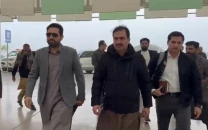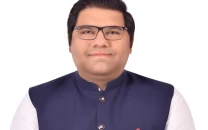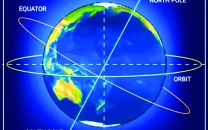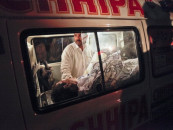Cartography: Tech enthusiasts gear up to map up Karachi
Whether it’s to find a restaurant or chart a disaster zone, Google maps is the key.

Cartography: Tech enthusiasts gear up to map up Karachi
Tech enthusiasts, Google fans and development workers gathered at the Institute of Business Administration (IBA) city campus computer lab on Friday to learn how to use Google maps to map their neighbourhood and city.
Led by Google country representative Badar Khushnood and a trio who are the most active map makers of Pakistan, the workshop enlightened around 40 participants about the importance of having a complete mapping interface for the country, guiding them through the process of mapping out their city and neighbouhood online.
Khushnood related how Google maps, in addition to its commercial uses and benefits, has been used for disaster management and relief work. He cited the example of the Attabad lake disaster and last year’s floods to emphasise the need to have a well-developed map interface to mobilise and expedite humanitarian initiatives.
Khushnood narrated the incident of a local resident who had helped map various points of disaster and mark needs at the time of the Attabad lake flooding by text messaging updates to Faraz Ahmed, one of the active map makers, who would then plot them. Another website, local.com.pk, launched by the trio of Faraz Ahmed, Omer Sheikh and Gibran Rafique used the Google interface to map out and speed up relief work during the 2010 floods and create a cloud cover layer on the map which could forecast where the rain and subsequent floods would come next.
Faraz, Gibran and Omer are among the 50 top mappers on Google Map Maker in the world and they have collectively contributed around 700 points of interest on the maps. What is interesting is that both Gibran and Faraz are not even based in Pakistan but continue to contribute to its Google maps from abroad.
“A major benefit of the internet is that it provides a level playing field for everyone,” said Khushnood.
At the time of the launch of Google maps in 2008, Pakistan was nowhere on the world map interface. But only a year into the launch, Pakistan had topped the Google Maps experiment. Pakistani web users were able to post more localised content to the maps than any of the 160 countries simultaneously taking part in the global search leader’s experiment.
“We started from four people and we have now increased to 40 to 50 people,” said Faraz Ahmed.
Map data is often available for download for non-profit use and is often used by organisations to produce helpful resources for humanitarian purposes. Saeed Ghani, the associate dean at the Faculty of Computer Sciences at IBA, spoke about how he and a group of students used the Google map interface to set up a separate Sindh Maps website to help with disaster management and relief and development activities throughout the province.
Map data is also available as satellite imagery set to possible real-time coordinates and is based on data provided by external organisations such as Nasa. Street views however, said Khushnood, would take some time to come to Pakistan. Currently, the process of map making and the speed with which the update is added to the map after moderation by other users also takes some time due to the requirement of each edit having to be approved by another user. Anybody can add an edit to a map and plot points of interest by logging in through their Gmail account. The edit is then approved or rejected by another user and then by Google before it goes up live. Google Map Maker however, does not allow users to add personal data.
The need for such community initiatives was voiced by the participants as well. “I work in the development sector and after I worked for flood relief I realised the importance of having this kind of interface where you can coordinate such humanitarian activities,” said Zahra Khan, a participant. “I therefore felt the need to come and learn how to use Google map maker.” Omer Sheikh added, quite aptly, “The idea is to get the participants started in the hope that they will continue mapping in the future.” It seems like there’s no stopping them now.
How to make a map on Google Map Maker
1. Sign in through your Gmail log-in and log on to <http://www.google.com/mapmaker>
2. Select an area where you want to plot a point of interest.
3. Select satellite view and zoom in on the area.
4. Click on add a point in the tabs on the left of the map. Select a preferred language, a category (restaurant, café, shopping centre or university etc), add in street address, contact information and description. You can also link a photo by adding a photo URL.
5. Save edit and wait for approval by other users.
6. You can also draw a road, railway, river, flyover etc by marking point A and B for the beginning and the end and adding details like the name and attributes of the road.
7. There are different forums where Pakistani map makers can also discuss issues and problems faced when making maps for example <http://www.groups.google.com/mappingpakistan> and <http://geography.pk>
Published in The Express Tribune, June 11th, 2011.
Correction: June 12, 2011
Due to an editing error, an earlier version of this story was titled 'Kartography: Tech enthusiasts gear up to map up Karachi'. This has been revised to 'Cartography: Tech enthusiasts gear up to map up Karachi'.



















COMMENTS
Comments are moderated and generally will be posted if they are on-topic and not abusive.
For more information, please see our Comments FAQ